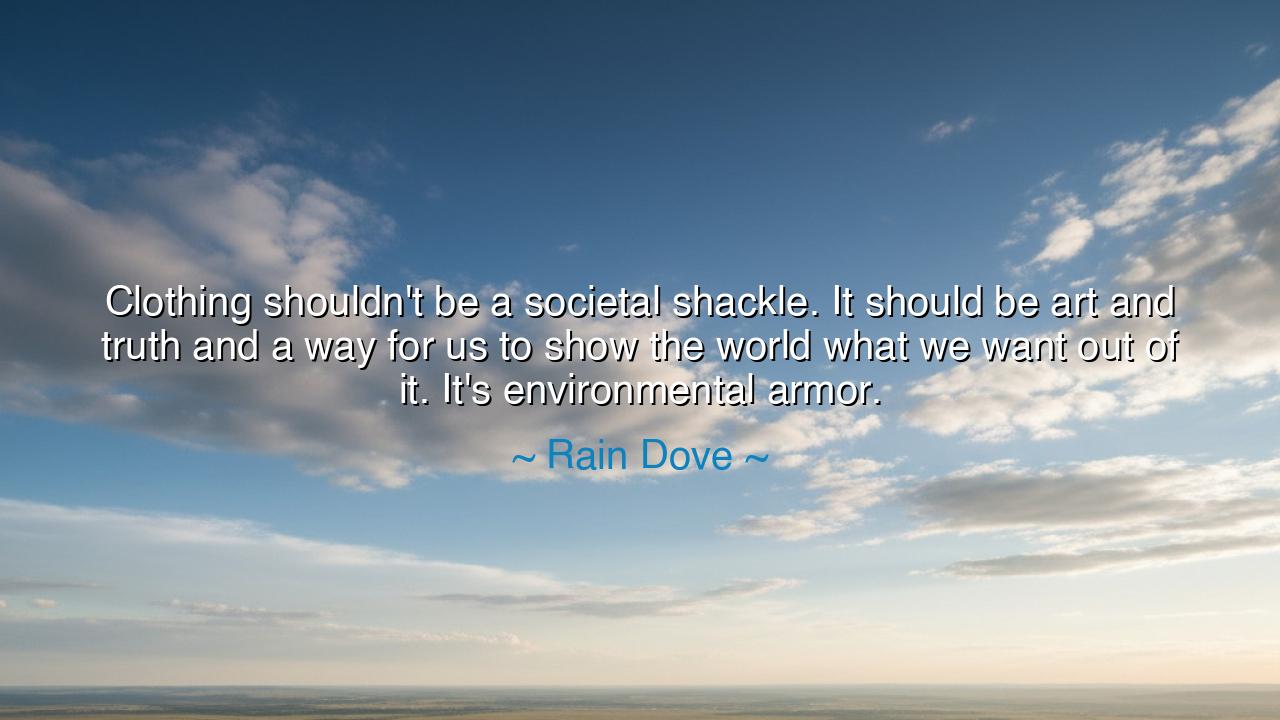
Clothing shouldn't be a societal shackle. It should be art and
Clothing shouldn't be a societal shackle. It should be art and truth and a way for us to show the world what we want out of it. It's environmental armor.






Hearken, children of tomorrow, to the words of Rain Dove, whose voice rose not as a whisper but as a thunderclap across the valleys of conformity: “Clothing shouldn’t be a societal shackle. It should be art and truth and a way for us to show the world what we want out of it. It’s environmental armor.” These words are no fleeting utterance, but a torch passed down through the corridors of time, urging mortals to lift their eyes from chains and behold the higher calling of clothing. What is this outer covering we drape upon our flesh? Is it but fabric and thread, or is it a mirror of the soul, a banner of freedom, and a declaration of who we are meant to be?
In the first breath of meaning, the word shackle resounds. Society, in its fear of disorder, has too often bound men and women with threads of expectation, commanding them to dress according to rank, gender, station, or creed. Yet Rain Dove declares rebellion against such chains. Clothing, they say, is not to be the iron clasp of judgment, but the flowing ink with which we write our truths upon the canvas of the world. It is art, pure and defiant, a radiant flare that calls forth the identity within.
Consider the story of Joan of Arc, the Maid of Orléans, who in her time defied the decrees of bishops and kings by donning armor deemed unfit for her sex. She did not garb herself for vanity, but for truth—to shield her body in battle and to proclaim her purpose before God and men. Her clothing became her testimony. She showed the world not what it demanded of her, but what she demanded of the world: courage, freedom, and faith. Was not her fate proof that what we wear is never merely cloth, but armor of spirit?
Thus Rain Dove’s vision is one of transformation: clothing as truth, clothing as voice, clothing as environmental armor. In the market of human eyes where judgment is swift, our garments may stand as shield and signal alike. To wear what reflects one’s inner fire is to stand upright in a storm. And in this act, clothing ceases to be vanity, and becomes destiny.
But let none think this teaching is only for warriors or prophets. Even in the quiet life, the farmer, the scholar, the laborer—each may find power in the garments they choose. To wear a simple robe in defiance of pomp, or to cloak oneself in vivid colors where gray is commanded, is to declare, “I will not be bound.” For in every era, those who dared to shape their identity through attire altered not only their fate, but the destiny of those who gazed upon them.
The lesson, then, is this: do not wear to please the chains of others, but to declare your freedom. Ask yourself each morning, “Does this fabric bind me, or does it set me free?” If it binds, cast it off. If it sets you free, let it shine upon you as the armor of your soul. Let clothing be your banner of truth, your song of art, and your shield against the judgments of a weary world.
And for practical wisdom: dare to experiment. Choose one garment this week that speaks your truth, whether bold or subtle. Let it reflect not who others think you are, but who you are becoming. Speak through your colors, protect yourself with your layers, and express your story with your textures. In time, the world shall not only see the armor you wear but the spirit you carry within it.
Thus, remember Rain Dove’s cry: clothing is no shackle, but armor. Wield it as the ancients wielded sword and shield—not to oppress, but to declare, to defend, and to inspire. Go forth, then, clothed not in chains, but in freedom.






AAdministratorAdministrator
Welcome, honored guests. Please leave a comment, we will respond soon